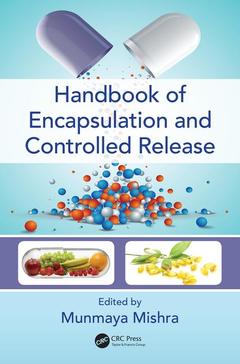Handbook of Encapsulation and Controlled Release Encapsulation and Controlled Release Series
Coordonnateur : Mishra Munmaya

The field of encapsulation, especially microencapsulation, is a rapidly growing area of research and product development. The Handbook of Encapsulation and Controlled Release covers the entire field, presenting the fundamental processes involved and exploring how to use those processes for different applications in industry. Written at a level comprehensible to non-experts, it is a rich source of technical information and current practices in research and industry.
This book is particularly designed for scientists and engineers working in various industries, including food, consumer products, pharmaceuticals, medicine, agriculture, nutraceuticals, dietary supplements, cosmetics, flavors, and fragrances. It offers a broad perspective on a variety of applications and processes, providing research information, figures, tables, illustrations, and references.
The book also lays the groundwork for further advancements in encapsulation technology and controlled release applications. Catering to professionals, researchers, students, and general readers in academia, industry, and research institutions, the Handbook of Encapsulation and Controlled Release is a much-needed reference on the state of the field and an authoritative resource for continued research and development in encapsulation and controlled release technologies.
FUNDAMENTALS. Overview of Encapsulation and Controlled Release. PROCESSES. Process-Selection Criteria. Microencapsulation by Spray Drying. Spray Drying and Its Application in Food Processing. Encapsulation via Spray Chilling/Cooling/Congealing. Encapsulation via Spinning Disk Technology. Encapsulation via Fluidized Bed Coating Technology. Encapsulation via Pan-Coating. Microencapsulation by Dripping and Jet Break-Up. Microencapsulation by Annular Jet Process. Encapsulation via Hot-Melt Extrusion. Microencapsulation with Coacervation. Encapsulation via Microemulsion. Ionotropic Gelation and Polyelectrolyte Complexation Technique: Novel Approach to Drug Encapsulation. Microencapsulation via Interfacial Polymerization. Microencapsulation via In Situ Polymerization. Microencapsulation with Miniemulsion Technology. Silica-Based Sol-Gel Microencapsulation and Applications. Microencapsulation by Phase Inversion Precipitation. Microfluidic Encapsulation Process. Encapsulation Process in Granulation Technology. Encapsulation via Electrohydrodynamic Atomization Spray Technology (Electrospray). Encapsulation Process: Pulsed Combustion Spray Drying. Supercritical Fluid Technology for Encapsulation. Melt-Dispersion Technique for Encapsulation. INGREDIENTS. Materials of Natural Origin for Encapsulation. Cellulose Ethers: Applications. Cellulose-Based Biopolymers: Formulation and Delivery Applications. Starch-Based Polymeric Biomaterial: Drug Delivery. Biodegradable Polymers: Drug Delivery Applications. CHARACTERIZATION. Encapsulation Field Polymers: Fourier Transform Infrared Spectroscopy (FTIR). APPLICATIONS. Encapsulation Technologies for Modifying Food Performance. Microencapsulation: Probiotics. Organogels as Food Delivery Systems. β-Lactoglobulin: Bioactive Nutrients Delivery. Encapsulation of Polyphenolics. Encapsulation of Bioactive Compounds. Encapsulation of Flavors, Nutraceuticals, and Antibacterials. Encapsulation of Aroma. Molecular (Cyclodextrin) Encapsulation of Volatiles and Essential Oils. Microencapsulation: Artificial Cells. Cell Encapsulation. Cell Immobilization Technologies for Applications in Alcoholic Beverages. Enzyme Immobilization in Biodegradable Polymers for Biomedical Applications. Emulsion-Solvent Removal System for Drug Delivery. Organogels in Controlled Drug Delivery. Microparticulate Drug Delivery Systems. Colloid Drug Delivery Systems. Melt Extrusion: Pharmaceutical Applications. Nanoparticles: Biomaterials for Drug Delivery. Polymer Systems for Ophthalmic Drug Delivery. Drug Delivery Systems: Oral Mucosal. Polymeric Biomaterials for Controlled Drug Delivery. Nanogels: Chemical Approaches to Preparation. Electrospinning Technology: Polymeric Nanofiber Drug Delivery. Polyelectrolyte Complexes: Drug Delivery Technology. Polymeric Nano/Microparticles for Oral Delivery of Proteins and Peptides. Vegetable Oil-Based Formulations for Controlled Drug Delivery. Introduction to Commercial Microencapsulation. Stable Core-Shell Microcapsules for Industrial Applications. Microencapsulation Applications in Food Packaging. Microencapsulation of Phase Change Materials.
Munmaya Mishra, Ph.D., is a polymer scientist who has worked in the industry for more than 30 years. He has been engaged in research, management, technology innovations, and product development. He currently holds research and technical management responsibility at Altria Research Center and serves as the Editor-in-Chief of three Taylor & Francis’ renowned polymer journals. He has contributed immensely to multiple aspects of polymer applications, including encapsulation and controlled release technologies. He has authored and coauthored hundreds of scientific articles, is the author or editor of eight books, and holds over 70 US patents, over 50 US patent-pending applications, and over 100 world patents. He has received numerous recognitions and awards. He is the editor-in-chief of the recently published 11-volume Encyclopedia of Biomedical Polymers and Polymeric Biomaterials and the Encyclopedia of Polymer Applications. He founded the International Society of Biomedical Polymers and Polymeric Biomaterials as well as a scientific meeting titled Advanced Polymers via Macromolecular Engineering, which has gained international recognition and is under the sponsorship of the International Union of Pure and Applied Chemistry.
Date de parution : 12-2015
Ouvrage de 1512 p.
17.8x25.4 cm
Thème de Handbook of Encapsulation and Controlled Release :
Mots-clés :
Drug Delivery; Drug Delivery Systems; Uidized Bed; Delivery Systems; Spray Drying; Cellulose Acetate Phthalate; Dosage Forms; Moisture Content; HPMCAS; Soy Protein; Ta Te; Hydroxypropyl Methyl Cellulose; microencapsulation; Solid Dispersions; capsule design; Organogels Formation; encapsulant; Situ Polymerization; matrix encapsulation; Complex Coacervation; Polynuclear capsules; Drying Chamber; mononuclear microcapsules; Hydroxypropyl Methyl Cellulose Acetate Succinate; Alginate Droplets; Transdermal Drug Delivery; Encapsulated Core Material; PAMAM Dendrimers; Triethyl Citrate; Tec; Hypromellose Acetate Succinate


